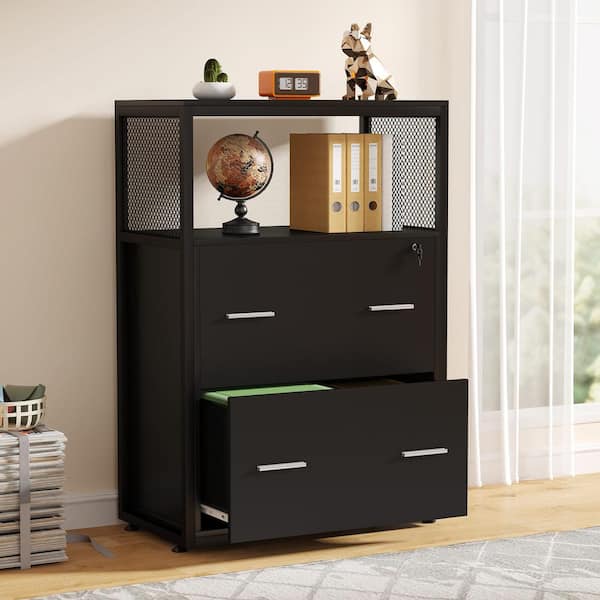Introduction
In today’s fast-paced and digital world, the need for physical file storage may seem outdated. However, there are still many circumstances where hard copies of documents are necessary, and it’s crucial to keep them secure. This is where file cabinets with locks come into play. These cabinets provide a safe and organized way to store important documents, ensuring that sensitive information is protected from unauthorized access. In this article, we will explore the importance of file cabinets with locks and the different features to consider when choosing one.
Part 1: The security benefits of file cabinets with locks
Level 1: Protection from unauthorized access
File cabinets are essential for securely storing sensitive documents as they provide physical protection from unauthorized access. By utilizing a lock, the cabinet ensures that only authorized individuals can access the contents inside, reducing the risk of theft or misuse of important documents.
Level 2: Compliance with privacy regulations
In industries such as healthcare, finance, and legal, there are strict regulations regarding the privacy and security of sensitive information. File cabinets with locks help businesses comply with these regulations by offering a secure storage solution for confidential client and patient records, ensuring that sensitive information is kept private and secure.
Part 2: Organizational benefits of file cabinets with locks
Level 1: Efficient storage and organization
File cabinets with locks offer an efficient way to store and organize documents, helping to keep your workspace clutter-free. By having designated drawers and folders within the cabinet, you can easily categorize and locate important documents when needed, saving time and promoting productivity.
Level 2: Protection from damage and deterioration
In addition to security, file cabinets with locks also provide protection from environmental factors that could damage or deteriorate sensitive documents. By keeping them safely stored away from potential hazards such as spills, sunlight, or dust, the cabinets help to preserve the integrity of the documents for a longer period.
Part 3: Factors to consider when choosing a file cabinet with a lock
Level 1: Locking mechanism
When selecting a file cabinet with a lock, it’s essential to consider the type of locking mechanism it utilizes. Options range from traditional key locks to electronic keypad locks, each offering different levels of security and convenience.
Level 2: Material and durability
The material and build quality of the file cabinet play a significant role in its ability to protect the contents. Cabinets made from sturdy materials such as steel offer enhanced durability and resistance to tampering, ensuring that your documents remain secure.
Part 4: Types of file cabinets with locks
Level 1: Vertical file cabinets
Vertical file cabinets are a popular choice for offices, as they provide a space-saving and organized storage solution. With a variety of locking options, including key locks and combination locks, they offer security and accessibility for a range of document storage needs.
Level 2: Lateral file cabinets
Lateral file cabinets are designed for larger storage capacities and can accommodate oversized documents or files. When equipped with locks, they provide secure storage for a high volume of documents, making them ideal for businesses with extensive paper trail storage needs.
Part 5: Tips for maintaining and organizing a file cabinet with lock
Level 1: Regular maintenance and inspection
To ensure the continued security and functionality of your file cabinet with a lock, it’s essential to perform regular maintenance and inspections. This includes checking the locking mechanism for any signs of wear or damage and addressing any issues promptly.
Level 2: Organization and labeling
Implementing a consistent organizational system and labeling for your file cabinet can significantly enhance its efficiency and usability. By categorizing and labeling each drawer or folder, it becomes easier to locate specific documents quickly and maintain a tidy and organized workspace.
Part 6: Importance of File Cabinets with Locks
File cabinets with locks are essential for keeping sensitive and confidential documents secure. These cabinets provide an added layer of security, preventing unauthorized access to important files. In today’s digital age, it’s easy to forget the importance of physical security for paper documents, but the reality is that many businesses still rely on hard copies for record-keeping. Without proper storage solutions, these documents could easily fall into the wrong hands.
For businesses that deal with sensitive client information, medical records, legal documents, or financial records, having a secure file cabinet is imperative. Not only does it protect the privacy and integrity of the information, but it also ensures compliance with privacy laws and regulations. In the event of a security breach, businesses could face serious legal and financial repercussions, making the investment in secure file cabinets well worth it.
Furthermore, file cabinets with locks also protect against internal threats. Employees with access to sensitive information could potentially misuse or tamper with documents if they are not properly secured. By implementing lockable file cabinets, businesses can mitigate the risk of internal data breaches and ensure that only authorized personnel have access to confidential files.
In addition to security, file cabinets with locks also help with organization and efficiency. By providing designated storage for important documents, these cabinets make it easier for employees to keep track of and access the files they need, saving time and improving productivity.
Part 7: Types of Locks for File Cabinets
There are several types of locks available for file cabinets, each offering different levels of security and convenience. Understanding the options can help businesses and individuals choose the right lock for their specific needs.
The most common type of lock for file cabinets is the traditional key lock. This simple and reliable option requires a physical key to unlock the cabinet, providing basic security. However, key locks can be cumbersome if multiple people need access to the same cabinet, as it requires sharing and keeping track of keys.
For added convenience, many file cabinets also come with combination locks. These locks require a numerical code to be entered in order to unlock the cabinet. Combination locks eliminate the need for keys, making it easier to grant access to multiple users without the hassle of managing physical keys.
For even higher security, some file cabinets are equipped with electronic or digital locks. These advanced locks often feature keypads or biometric scanners, requiring a unique code or fingerprint to gain access. Electronic locks offer the highest level of security and can track access history, providing an added layer of accountability.
Additionally, some file cabinets can be retrofitted with aftermarket locks, allowing users to upgrade the security of their existing cabinets. These retrofit locks come in a variety of styles and can be installed without the need for professional assistance. This allows businesses and individuals to customize the security of their file cabinets to meet their specific needs.
Part 8: Choosing the Right File Cabinet with Lock
When selecting a file cabinet with a lock, there are several factors to consider to ensure that it meets the needs of the business or individual. The first consideration is the level of security required. For highly sensitive documents, such as legal or medical records, a high-security lock, such as an electronic or biometric lock, may be necessary. For less critical files, a traditional key lock may suffice.
Another important consideration is the size and capacity of the file cabinet. It’s essential to choose a cabinet that can accommodate the volume of files that need to be stored securely. Additionally, the cabinet should be durable and well-constructed to protect against forced entry or damage.
Ease of use and accessibility are also important factors to consider. For cabinets that will have multiple users, a combination lock may be more convenient than a key lock, as it eliminates the need for physical keys. Electronic locks offer the highest level of security and can also provide detailed access history, making them a good choice for businesses requiring accountability.
Finally, aesthetics and design should be taken into account when selecting a file cabinet with a lock. The cabinet should complement the existing office decor and provide a professional and organized appearance. By taking these factors into consideration, businesses and individuals can choose a file cabinet with a lock that meets their specific security, storage, and accessibility needs.
Conclusion
File cabinets with locks play a crucial role in safeguarding sensitive information and promoting organization in various professional settings. By providing security, organization, and protection for important documents, they are an essential asset for businesses and individuals alike. When selecting a file cabinet with a lock, it’s important to consider the security benefits, organizational advantages, and various factors and types available, ultimately ensuring that your sensitive information remains safe and accessible.






